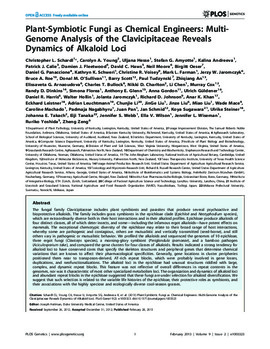| dc.contributor.author | Christopher L. Schardl | |
| dc.contributor.author | Carolyn A. Young | |
| dc.contributor.author | Uljana Hesse | |
| dc.contributor.author | Stefan G. Amyotte | |
| dc.contributor.author | Kalina Andreeva | |
| dc.contributor.author | Patrick J. Calie | |
| dc.contributor.author | Damien J. Fleetwood | |
| dc.contributor.author | David C. Haws | |
| dc.contributor.author | Neil Moore | |
| dc.contributor.author | Birgitt Oeser | |
| dc.contributor.author | Daniel G. Panaccione | |
| dc.contributor.author | Kathryn K. Schweri | |
| dc.contributor.author | Christine R. Voisey | |
| dc.contributor.author | Mark L. Farman | |
| dc.contributor.author | Jerzy W. Jaromczyk | |
| dc.contributor.author | Bruce A. Roe | |
| dc.contributor.author | Donal M. O'Sullivan | |
| dc.contributor.author | Barry Scott | |
| dc.contributor.author | Paul Tudzynski | |
| dc.contributor.author | Zhiqiang An | |
| dc.contributor.author | Elissaveta G. Arnaoudova | |
| dc.contributor.author | Charles T. Bullock | |
| dc.contributor.author | Nikki D. Charlton | |
| dc.contributor.author | Li Chen | |
| dc.contributor.author | Murray Cox | |
| dc.contributor.author | Randy D. Dinkins | |
| dc.contributor.author | Simona Florea | |
| dc.contributor.author | Anthony E. Glenn | |
| dc.contributor.author | Anna Gordon | |
| dc.contributor.author | Ulrich Güldener | |
| dc.contributor.author | Daniel R. Harris | |
| dc.contributor.author | Walter Hollin | |
| dc.contributor.author | Jolanta Jaromczyk | |
| dc.contributor.author | Richard D. Johnson | |
| dc.contributor.author | Anar K. Khan | |
| dc.contributor.author | Eckhard Leistner | |
| dc.contributor.author | Adrian Leuchtmann | |
| dc.contributor.author | Chunjie Li | |
| dc.contributor.author | JinGe Liu | |
| dc.contributor.author | Jinze Liu | |
| dc.contributor.author | Miao Liu | |
| dc.contributor.author | Wade Mace | |
| dc.contributor.author | Caroline Machado | |
| dc.contributor.author | Padmaja Nagabhyru | |
| dc.contributor.author | Juan Pan | |
| dc.contributor.author | Jan Schmid | |
| dc.contributor.author | Koya Sugawara | |
| dc.contributor.author | Ulrike Steiner | |
| dc.contributor.author | Johanna E. Takach | |
| dc.contributor.author | Eiji Tanaka | |
| dc.contributor.author | Jennifer S. Webb | |
| dc.contributor.author | Ella V. Wilson | |
| dc.contributor.author | Jennifer L. Wiseman | |
| dc.contributor.author | Ruriko Yoshida | |
| dc.contributor.author | Zheng Zeng | |
| dc.date.accessioned | 2016-01-08T19:47:48Z | |
| dc.date.accessioned | 2016-03-30T15:31:00Z | |
| dc.date.available | 2016-01-08T19:47:48Z | |
| dc.date.available | 2016-03-30T15:31:00Z | |
| dc.date.issued | 2013-02-28 | |
| dc.identifier.citation | Schardl CL, Young CA, Hesse U, Amyotte SG, Andreeva K, Calie PJ, et al. (2013) Plant-Symbiotic Fungi as Chemical Engineers: Multi-Genome Analysis of the Clavicipitaceae Reveals Dynamics of Alkaloid Loci. PLoS Genet 9(2): e1003323. doi:10.1371/journal.pgen.1003323 | en_US |
| dc.identifier.uri | https://hdl.handle.net/11244/23533 | |
| dc.description | We thank Richard M. Higashi and Teresa W. M. Fan of the University of Louisville Center for Regulatory and Environmental Analytical Metabolomics (supported by NSF EPSCoR grant EPS-0447479), together with Jerome R. Faulkner, University of Kentucky, and for identification of 1-acetamidopyrrolizidine; Abbe Kesterson and Alfred D. Byrd of the University of Kentucky Advanced Genetic Technologies Center for assistance in DNA sequencing; and John May of the University of Kentucky Environmental Research Training Laboratories for assistance in loline alkaloid analysis. This is publication number 13-12-004 of the Kentucky Agricultural Experiment Station, published with approval of the director. | en_US |
| dc.description | | en_US |
| dc.description.abstract | Author Summary The fungal family, Clavicipitaceae, includes “ergot” fungi that parasitize ears of cereals and have historically caused mass poisonings, as well as “epichloae,” which are symbionts of grasses. Many epichloae are mutualistic symbionts, but some are pathogenic, and others have both mutualistic and pathogenic characteristics. Most Clavicipitaceae produce “alkaloids,” small molecules that deter insects, livestock, and wildlife from feeding on the fungus or plant. Epichloae protect their hosts with diverse alkaloids belonging to four chemical classes. After sequencing the entire DNA contents (“genomes”) of ten epichloae, three ergot fungi, and two relatives, we compared their “clusters” of genes for alkaloid biosynthesis. In the epichloae, these clusters contained extraordinarily large blocks of highly repetitive DNA, which promote gene losses, mutations, and even the evolution of new genes. These repeat blocks account for the exceptionally high alkaloid diversity in the epichloae and may relate to the ecological diversity of these symbiotic fungi. | en_US |
| dc.language.iso | en_US | en_US |
| dc.publisher | PLos Genetics | |
| dc.relation.ispartofseries | PLoS Genet 9(2):e1003323 | |
| dc.relation.uri | http://www.plosgenetics.org/article/info%3Adoi%2F10.1371%2Fjournal.pgen.1003323 | |
| dc.rights | Attribution 3.0 United States | |
| dc.rights.uri | https://creativecommons.org/licenses/by/3.0/us/ | |
| dc.subject | Alkaloids,Genetic loci,Fungal genomics,Plant genomics,Telomeres,Sequence assembly tools,Fungi,Repeated sequences | en_US |
| dc.title | Plant-Symbiotic Fungi as Chemical Engineers: Multi-Genome Analysis of the Clavicipitaceae Reveals Dynamics of Alkaloid Loci | en_US |
| dc.type | Research Article | en_US |
| dc.description.peerreview | Yes | en_US |
| dc.description.peerreviewnotes | http://www.plosgenetics.org/static/editorial#peer | en_US |
| dc.identifier.doi | 10.1371/journal.pgen.1003323 | en_US |
| dc.rights.requestable | false | en_US |

